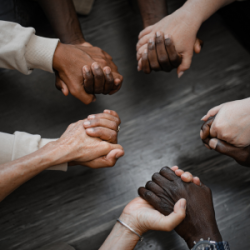Welcome readers! Please subscribe through the buttons on the right if you enjoy this post.
(Read this series from its beginning here.)

Jesus’ solidarity with those on the margins of his society is not just a characteristic of Luke’s Jesus. Each of the Gospels begins on the margins. John the Baptist rejected his more central role of being a priest in the temple. He was a voice crying out in the wilderness. Jesus was from the marginalized region of Galilee and the majority of his story takes place here as well. This had deep, encouraging, political significance for the marginalized audiences of each of these gospels. “While the margin has a primarily negative political connotation as a place of disenfranchisement, Mark ascribes to it a primarily positive theological value. It is the place where the sovereignty of God is made manifest, where the story of liberation is renewed, where God’s intervention in history occurs.” (Ched Myers, Say to This Mountain: Mark’s Story of Discipleship, p. 12)
What does this mean for those Jesus followers whose present social location is not marginalized but more centered? The temptation is often to call for those at the center to make room at their table for those more marginalized. Miguel A. De La Torre offers a different option. This option does not invite those on the margins to a table at the center of an oppressive society where God is not. But to recognize that God is already present at the tables of those presently on the margins; God is already at work there. God is with them and we are only with God when we, too, are with them.
The question for those endeavoring to follow Jesus whose social location is more central and privileged is whether they will reject a status quo that privileges some over others on the basis simply of difference and begin supporting and working alongside those our society relegates to the margins. God is already there. The question is: are we?
“In reality, the gospel is thriving in the margins of society. The real question facing the center, accustomed to confusing its interpretations with the biblical text itself, is whether those at the center will also participate in the body of Christ that already exists in the margins of society.” (Miguel A. De La Torre, Reading the Bible from the Margins, Kindle location 1075)
Jesus’ solidarity with those on the margins reached a critical breaking point with Jesus’ protest in the courtyard of the temple. The temple was the political, economic, and religious symbol of the temple state of his own society. Don’t think of the temple as a modern Christian church. The temple was much more like a state’s capital building. This was the center of power. Jesus’ protest in his flipping over the tables of the money changers was the decisive move in the synoptic gospels which marks the threat of Jesus’ teaching as having gone too far. His temple protest damaged temple property and threatened the income of those power-brokers who were at the center of a system that economically exploited the poor. The growing number of followers of Jesus each day meant to those in power that something must be done. This is where we see the machinery of Roman “law and order enter” the story. Before the week is over, Jesus is hanging on a Roman cross.













